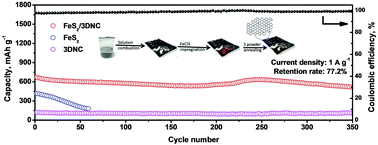Scalable synthesis of FeS2 nanoparticles encapsulated into N-doped carbon nanosheets as a high-performance sodium-ion battery anode†
Abstract
Pyrite (FeS2) has been considered as one of the most potential anode materials for sodium ion batteries (SIBs) due to its low cost, environmentally friendly features and high theoretical capacity. However, the huge volume changes during a charge/discharge process and poor conductivity of FeS2 hindered its practical applications. Herein, we propose a facile scalable approach to prepare nanostructured FeS2 embedded in an N-doped carbon nanosheet composite (FeS2/CNS) via a combined template method and a solid state sulfuration method. N-Doped carbon nanosheets are believed to alleviate the volume variation and enhance the conductivity of an electrode, and the nanoscale particle size with an average diameter of 50–80 nm can shorten the ion-diffusion paths during a sodiation/desodiation process. As a result, the FeS2/CNS electrode exhibits high specific capacity (812 mA h g−1 at 0.1 A g−1), long cycling life (77.2% capacity retention after 350 cycles at 1 A g−1) and excellent rate capability (400 mA h g−1 at 5 A g−1) when tested as an anode material for SIBs. The results demonstrate the potential applications of FeS2/CNS in SIBs with low-cost, high power density and long cycling life.

- This article is part of the themed collections: Editor’s Choice: 2D Materials for Energy Storage and Conversion, 2019 Nanoscale HOT Article Collection and Materials and Nano Research in Atlanta


 Please wait while we load your content...
Please wait while we load your content...